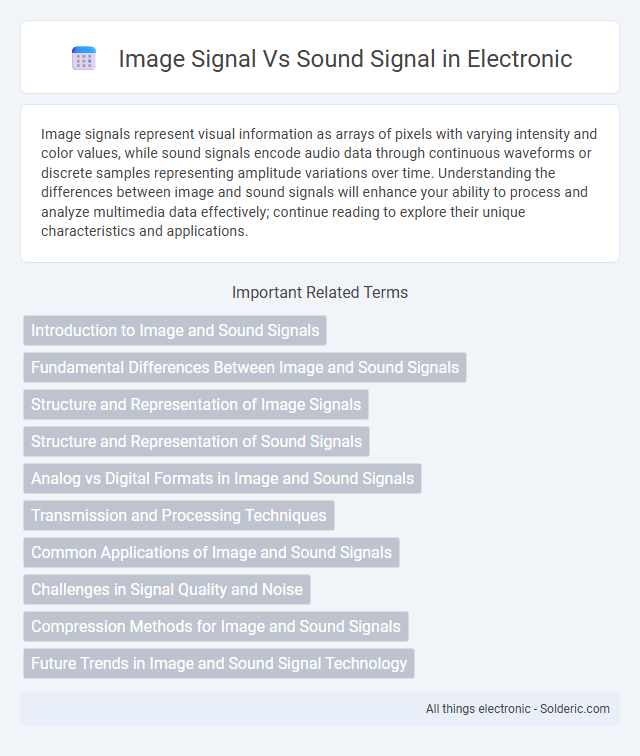Image signals represent visual information as arrays of pixels with varying intensity and color values, while sound signals encode audio data through continuous waveforms or discrete samples representing amplitude variations over time. Understanding the differences between image and sound signals will enhance your ability to process and analyze multimedia data effectively; continue reading to explore their unique characteristics and applications.
Comparison Table
| Feature | Image Signal | Sound Signal |
|---|---|---|
| Nature | Visual data representing light intensity and color | Audio data representing variations in air pressure |
| Frequency Range | Typically 400-700 THz (visible light) | 20 Hz - 20 kHz (audible sound) |
| Medium | Electromagnetic waves, no medium required | Mechanical waves, requires a medium (air, water) |
| Signal Type | Analog or digital pixel intensity data | Analog or digital pressure wave data |
| Common Formats | JPEG, PNG, BMP (digital) | MP3, WAV, AAC (digital) |
| Sampling | Typically spatial resolution (pixels per inch) | Sampling rate in kHz (44.1 kHz standard) |
| Processing Techniques | Image enhancement, edge detection, compression | Noise reduction, echo cancellation, compression |
| Applications | Photography, medical imaging, video streaming | Telecommunication, music, speech recognition |
Introduction to Image and Sound Signals
Image signals represent visual information through variations in brightness and color captured as pixels, while sound signals convey audio information via waveforms characterized by amplitude and frequency. Both signals are fundamental in multimedia systems, enabling the transmission and processing of visual and auditory data. Understanding the differences in their encoding and sampling methods allows you to optimize quality and storage efficiency in digital communications.
Fundamental Differences Between Image and Sound Signals
Image signals are typically two-dimensional, representing spatial information through pixels with intensity and color values, while sound signals are one-dimensional, capturing temporal variations in air pressure as waveforms. Image signals rely on frequency components related to spatial resolution, whereas sound signals depend on time-based frequency variations corresponding to pitch and tone. The processing techniques for image signals emphasize filtering and enhancement of spatial features, whereas sound signal processing focuses on time-frequency analysis and waveform modulation.
Structure and Representation of Image Signals
Image signals consist of two-dimensional arrays of pixel data representing visual information, where each pixel contains intensity or color values typically encoded in formats such as RGB or grayscale. Their structure is spatially organized, enabling detailed representation of texture, edges, and patterns, essential for image processing tasks. Unlike one-dimensional sound signals that vary over time, image signals are static matrices capturing spatial variations, requiring specialized compression methods like JPEG or PNG to efficiently store and transmit.
Structure and Representation of Sound Signals
Sound signals are represented as continuous waveforms characterized by amplitude, frequency, and phase variations over time, often modeled as analog signals or converted into digital format via sampling and quantization for processing. The structure of sound signals includes components like fundamental frequencies and harmonics, which define timbre and pitch, and transient elements that capture attack and decay in acoustic events. Unlike image signals that encode spatial information as pixels, sound signals inherently convey temporal information crucial for distinguishing speech, music, and environmental sounds.
Analog vs Digital Formats in Image and Sound Signals
Analog image signals capture continuous variations in light intensity, producing smooth gradients, while digital image signals convert these variations into discrete pixel values for precise editing and storage. Similarly, analog sound signals represent continuous sound waves, preserving natural audio nuances, whereas digital sound signals sample and quantize these waves into binary data for enhanced noise resistance and easy manipulation. Understanding these distinctions helps you choose the best signal format for applications requiring either fidelity or flexibility.
Transmission and Processing Techniques
Image signals primarily rely on techniques such as analog-to-digital conversion, compression algorithms like JPEG or HEVC, and modulation methods including amplitude or frequency modulation for efficient transmission and processing. Sound signals use pulse-code modulation (PCM), Fourier transform for frequency analysis, and compression standards like MP3 or AAC to reduce bandwidth while maintaining audio quality during transmission. Your choice of signal type dictates specific processing and transmission protocols, optimizing bandwidth utilization and preserving signal fidelity.
Common Applications of Image and Sound Signals
Image signals are commonly used in medical imaging, satellite imaging, and facial recognition systems for detailed visual information processing. Sound signals play a crucial role in telecommunications, speech recognition, and audio broadcasting by capturing and transmitting auditory information. Both image and sound signals are essential in multimedia applications, enhancing user experience through synchronized visual and auditory data.
Challenges in Signal Quality and Noise
Image signals often suffer from challenges like pixelation, blurring, and color distortions caused by low resolution or compression artifacts, whereas sound signals face issues such as background noise, echo, and signal attenuation impacting clarity. Both signal types require advanced filtering and noise reduction algorithms to maintain high-quality transmission and accurate interpretation. Your choice of hardware and processing techniques directly influences how effectively these challenges are managed to optimize overall signal quality.
Compression Methods for Image and Sound Signals
Compression methods for image signals primarily use techniques such as JPEG, which employs discrete cosine transform (DCT) to reduce spatial redundancy, and wavelet-based compression that preserves high-frequency details. Sound signal compression relies on algorithms like MP3 and AAC, utilizing perceptual coding to eliminate inaudible components and reduce temporal redundancy. Your choice of compression method impacts quality and file size, balancing fidelity and efficiency for storage or transmission.
Future Trends in Image and Sound Signal Technology
Future trends in image and sound signal technology emphasize the integration of AI-driven processing for enhanced resolution and clarity, enabling more immersive multimedia experiences. Advancements in neural networks improve real-time noise reduction and semantic understanding of visual and audio data, transforming how you interact with digital content. Emerging technologies like hyperspectral imaging and spatial audio continue to push the boundaries of signal fidelity and contextual awareness in entertainment, healthcare, and communication industries.
image signal vs sound signal Infographic

 solderic.com
solderic.com